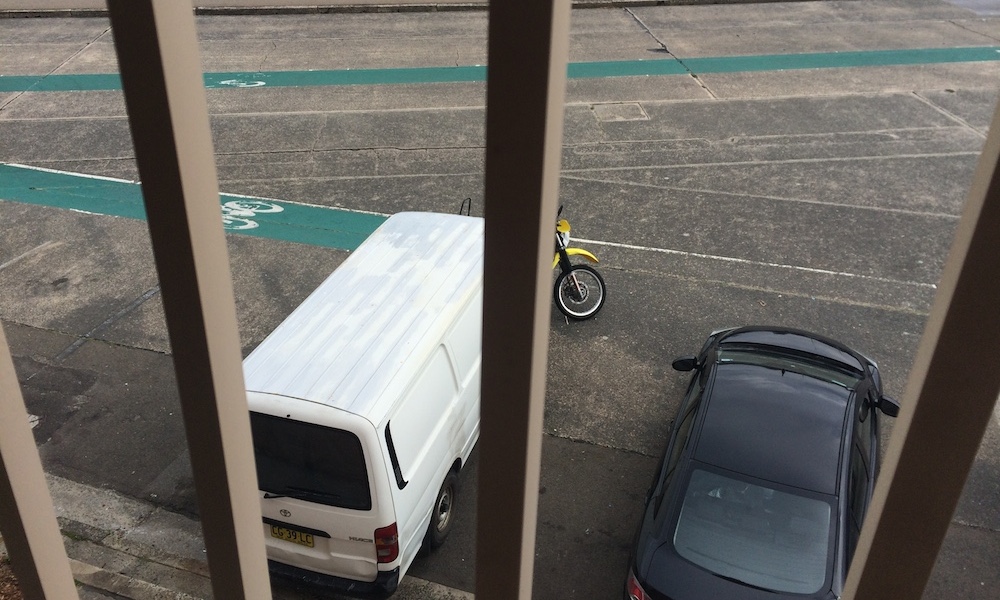Many of us dream of reducing our carbon footprint by leading a more self sustainable life; living in a house with a big backyard consisting of a vegetable garden and chickens. I do. But then I am torn from the fantasy and propelled back into consciousness by the bellowing sound of traffic or sirens outside my inner city apartment.

This is the view from my front window. No green in sight. I live in a small one bedroom apartment with no balcony. Instead there is a 4m by 4m sunroom which gazes over the concrete promenade in front of my building. I do love my home, however it poses some challenges when it comes to sustainable living.
Despite the concrete surrounds and lack of an outdoor living area, there are a few simple ways I have adapted to urban living to live more sustainably and reduce my environmental impact.
Here's how to do it.
Create a herb garden
Although maintaining a vegetable garden may not be feasible for many urban dwellers, herb gardens can flourish in an apartment environment, even if you don't have a balcony.
If you do have a shared courtyard or outside living area, plants like tomatoes, basil and some lettuces grow very well in the Australian climate.
If this isn't an option, many edible plants can thrive indoors, including chilli, parsley and chives. Just make sure they're exposed to lots of natural sunlight.
Save, reduce and recycle water
On average, each Australian uses approximately 340 litres of water each day. That is about 4 bathtubs of water. There are several ways to reduce your water usage without having to install a rainwater tank; which is generally not possible for those living in an apartment complex. Some of the obvious water saving methods include taking shorter showers and turning the tap off while you brush your teeth, however there are many other small ways to minimise water use.
Installing a cistern displacement device, or in layman's terms a 'toilet tummy' can save a litre of water each flush and do wonders for your water bill. The device is a simple water collecting bag that is easily installed in your toilet tank. It works by collecting and holding excess water that would otherwise be flushed.
If you grow plants, kitchen suds can in some cases be used for watering, often benefiting plant growth. Benefits are dependent on the type of plants you grow and the ingredients in your detergent, so make sure to do your research before getting started.
Waste not, want not
In Australia alone, four million tonnes of food waste goes into landfill each year. This staggering figure is representative of one of our largest climate change culprits. Global food waste is the third largest CO2 emitter, after the US and China. A great way to eliminate your own food waste is by planning weekly meals before each shop. Purchasing the exact amount of food required for each meal and cooking root to stem is the best way to go about minimising waste.
Using the scraps that can't be eaten can be achieved through maintaining a compost bin. Food scraps including most vegetable shavings, coffee grounds and tea (minus the bag) can be used to fertilise plants. Foods to avoid include meat and highly acidic foods like citrus fruits and onion.
Cut the plastic out of your life
Plastic, a material that has been designed and manufactured to last forever, is often created and distributed for one time use. Only 10 per cent of plastic is recycled, with the remaining 90 per cent ending up in landfill, much of it eventually ending up in the ocean. Cutting plastic out of your life can be as simple as using cloth bags to do your shopping, using food containers instead of plastic wrap to store food, ensuring that the food you buy either has no plastic wrapping or comes in a recyclable container like an aluminium can, and generally saying "no thanks" to the plastic bag.
Buy local produce
Going to the local food market and asking the vendors where their produce has come from, how it was produced and how it got from A to B can help you measure the environmental impact of your food's production and its journey from paddock to plate.

Food from local vendors is almost always more sustainably produced. When we buy from large supermarket chains, the origins of our food is often kept under wraps. For those who have taken the time to investigate exactly where the produce is coming from, you will be well aware that in many cases it comes from far and wide via planes, trucks and ships. Selecting food according to how far it has travelled and by which means can help reduce your environmental impact. For example, food which has travelled by plane emits far more CO2 than food that has travelled by ship.
Although total self-sustainability is not an option for everyone, living a cleaner, greener lifestyle is often simpler than we think, even when living in an urban jungle like I do.
Read this next: How to recycle things you didn't think you could recycle
We're in a climate emergency and it's going to take all of us to get out of it. That's why 1 Million Women is building a global community of women committed to fighting climate change with our daily actions. To join the (free) movement just click the button below!

